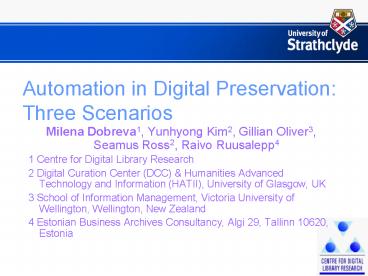Automation in Digital Preservation: Three Scenarios - PowerPoint PPT Presentation
1 / 15
Title:
Automation in Digital Preservation: Three Scenarios
Description:
2 Digital Curation Center (DCC) & Humanities Advanced ... 3 School of Information Management, Victoria University of Wellington, Wellington, New Zealand ... – PowerPoint PPT presentation
Number of Views:24
Avg rating:3.0/5.0
Title: Automation in Digital Preservation: Three Scenarios
1
Automation in Digital PreservationThree
Scenarios
- Milena Dobreva1, Yunhyong Kim2, Gillian Oliver3,
Seamus Ross2, Raivo Ruusalepp4 - 1 Centre for Digital Library Research
- 2 Digital Curation Center (DCC) Humanities
Advanced Technology and Information (HATII),
University of Glasgow, UK - 3 School of Information Management, Victoria
University of Wellington, Wellington, New Zealand - 4 Estonian Business Archives Consultancy, Algi
29, Tallinn 10620, Estonia
2
Talk overview
2
Three case studies
Findings
What comes next?
3
The Preservation Landscape
if we do not actively pursue the preservation
of digital material now, we risk having a gap in
our intellectual record. If you allow me
another historical reference, we do not want to
experience the digital equivalent of the
destruction of the Alexandria Library. Scientific
assets are just too valuable to be put at risk.
Ms. Viviane Reding, EU Commissioner on IS
Media The digital preservation communitys
inability to bring firm evidence to bear in
support of its contentions about data loss,
coupled with the alarmist rhetoric of terms such
as digital dark ages and digital black hole,
leave us exposed. Prof. Ross Harvey,Charles
Sturt University, NSW, Australia
4
- Digital preservation
- part of the information management
- highly interdisciplinary
- What actually interoperability into the future
means? - preservation of the bit streams
- preservation of semantics
- A coherent theory of preservation is still not
developed - need justified in 2001
- currently CASPAR and SHAMAN projects are working
in this direction
5
Typical preservation issues
- Failure of any component of the technological
chain - Hardware, software or support environment change.
- Outcomes of a project which is not sustained.
- Problems with the the bits
- This could happen because of a storage device or
medium failure - or if a DNS entry is no longer resolvable.
- Changes in the Knowledge Base
- Loss of understanding or usability
- Lost data on provenance or authenticity
(requirements of trusted repositories) - Record of who did what and how did they do it
- Strategies migration, emulation, digital
archaeology,
6
DigitalPreservationEurope Research Roadmap
(2007) 9 themes
- Restoration
- Conservation
- Collection and Repository Management
- Preservation as Risk Management
- Preserving the Interpretability and Functionality
of Digital Objects - Collection Cohesion and Interoperability
- Automation in Preservation
- Preserving the Context
- Storage Technologies and Methods
7
Functional Model Open Archival Information
System (OAIS)
8
2
Three case studies
- Build upon project experiences of HATII at the
University of Glasgow and partners - Appraisal
- Metadata extraction based on genre classification
- Risk assessment and audit
9
Appraisal
- Approach developed sets of appraisal criteria
work on automation of their evaluation continues.
10
Metadata Extraction Based on Genre Classification
11
Risk Assessment and Audit
- DRAMBORA (Digital Repository Audit Method Based
on Risk Assessment)
12
The Three Case Studies as OAIS Functional
Entities
13
SWOT observations
14
Findings
- These case studies present various functions in
the sense of OAIS model. - For such smaller digital preservation solutions
we need to know more on the common logic. - For bigger applications a coherent theory will be
helpful. - The degree of automation differs!
- Profiler
- Single automated model
- Hybrid model
15
Questions?milena.dobreva_at_strath.ac.uk

